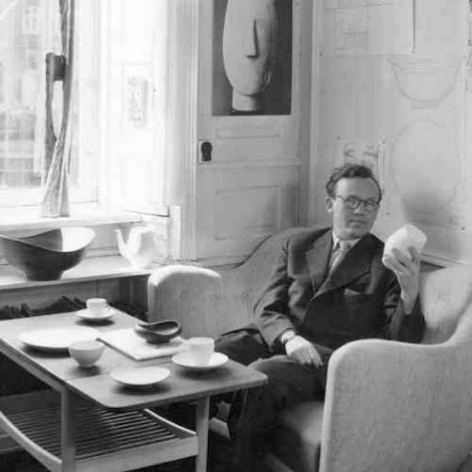

The 1950 Wall Sofa is an excellent example of Finn Juhl's tropism for the so-called free art of his time, but also of his ambition to defy gravity and create movement. Finn Juhl used this sofa in several of his interior design projects, such as the Villa Aubertin in Denmark, which he designed in 1952, and the Nordenfjeldske Kunstindustri-museum in Trondheim, Norway.
Finn Juhl's extravagant chairs and sofas from the 1940s and early 1950s are profoundly original. No other furniture designer gave such radical expression to the surreal sculptural forms that dominated that period, in parallel with the trends that were prevalent on the art scene.
The asymmetrical, generously upholstered backrest floats like a René Magritte cloud above the levitating seat, supported by an almost invisible frame. The unusual shape of the backrest is perfectly adapted to the human body, allowing you to sit comfortably in a variety of ways.
The powder-coated tubular steel frame is fixed to the wall, hence the name of the sofa. The sofa is hand-upholstered in Denmark and upholstered in fabric.
Dimensions 192 x 80 x H102 cm – Seat height 37 cm
Materials folded tubular steel frame

Wall Sofa
from
Remix 823 + Remix 796

As a teenager, Finn Juhl (1912-1989) wanted to become an art historian after having been fascinated by fine arts since childhood. His father prevented him from doing so and he studied architecture. Later, once his reputation as a furniture designer had been acquired, he would speak of himself as a self-taught man, certainly in reference to this thwarted vocation which forced him to make his intellectual journey alone. His very singular style owes much to this non-linear trajectory, with a very unacademic interpretation of art visible in his work. Finn Juhl began his studies in 1930, a key period that saw the birth of modern design and furniture.
His ultra-modern offices in the center of Copenhagen greeted visitors with a huge Japanese paper fish, a symbol of imagination. And rather than approaching furniture design from a functional, classical perspective, Finn Juhl approached his work as a sculptor. He sought beauty in volume and form, life and expressiveness. An approach that in the 1940's and 1950's was totally unprecedented. For Finn Juhl, it was clear that a piece of furniture could not be limited to a function, but also had to express an artistic sensibility.
While he remains world-famous for his furniture, Finn Juhl also designed several interior architecture projects and a few industrial products, including IBM typewriters. His greatest commercial success was with the Baker Company in the United States, which allowed him to mass-produce several pieces of furniture.
As an architect, he is known for the interior design of the United Nations Council in New York.